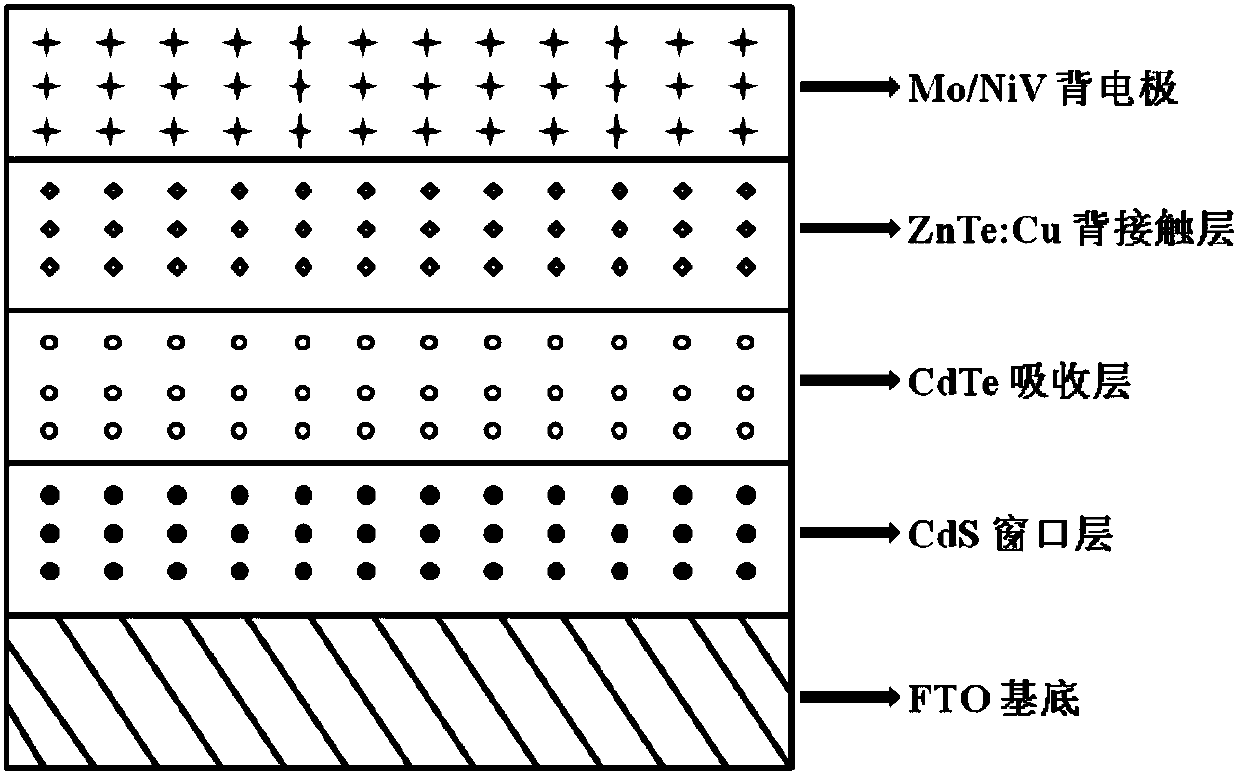Cadmium telluride thin film battery with composite back electrode and preparation method of battery
A cadmium telluride, back electrode technology, applied in circuits, photovoltaic power generation, electrical components and other directions, can solve the problems of high raw material cost, affect the final performance of the battery, and high preparation cost, reduce interface loss, improve collection and transfer capacity, The effect of improving photoelectric performance
- Summary
- Abstract
- Description
- Claims
- Application Information
AI Technical Summary
Problems solved by technology
Method used
Image
Examples
Embodiment 1
[0036] Such as figure 1 As shown, a cadmium telluride thin film solar cell with a composite back electrode is sequentially arranged with an FTO conductive glass substrate layer, a cadmium sulfide window layer, a cadmium telluride absorption layer, a copper-doped zinc telluride absorption layer, and a molybdenum / nickel vanadium composite Back electrode layer. The thickness of the substrate layer is 50 nm, the thickness of the window layer is 100 nm, the thickness of the absorption layer is 2.5 μm, the thickness of the back contact layer is 20 nm, and the thickness of the composite back electrode layer is 200 nm.
[0037] The method for preparing the above-mentioned cadmium telluride thin film solar cell includes the following steps:
[0038] (1) Using FTO conductive glass as the substrate material, the thickness of the conductive film is 50nm, and it is cut into a size of 2.5cm×4cm. The ultrasonic cleaning method is used to clean with anhydrous ethanol solution, acetone solution an...
Embodiment 2
[0047] Such as figure 1 As shown, a cadmium telluride thin film solar cell with a composite back electrode is sequentially arranged with an FTO conductive glass substrate layer, a cadmium sulfide window layer, a cadmium telluride absorption layer, a copper-doped zinc telluride absorption layer, and a molybdenum / nickel vanadium composite Back electrode layer. The thickness of the substrate layer is 100 nm, the thickness of the window layer is 150 nm, the thickness of the absorption layer is 3 μm, the thickness of the back contact layer is 40 nm, and the thickness of the composite back electrode layer is 250 nm.
[0048] The method for preparing the above-mentioned cadmium telluride thin film solar cell includes the following steps:
[0049] (1) Using FTO conductive glass as the substrate material, the thickness of the conductive film is 100nm, and it is cut into a size of 2.5cm×4cm. The ultrasonic cleaning method is used, followed by anhydrous ethanol solution, acetone solution, an...
Embodiment 3
[0058] Such as figure 1 As shown, a cadmium telluride thin film solar cell with a composite back electrode is sequentially arranged with an FTO conductive glass substrate layer, a cadmium sulfide window layer, a cadmium telluride absorption layer, a copper-doped zinc telluride absorption layer, and a molybdenum / nickel vanadium composite Back electrode layer. The thickness of the substrate layer is 150 nm, the thickness of the window layer is 200 nm, the thickness of the absorption layer is 3.5 μm, the thickness of the back contact layer is 60 nm, and the thickness of the composite back electrode layer is 500 nm.
[0059] The method for preparing the above-mentioned cadmium telluride thin film solar cell includes the following steps:
[0060] (1) Use FTO conductive glass as the substrate material, the thickness of the conductive film is 150nm, cut it into a size of 2.5cm×4cm, use the ultrasonic cleaning method, wash with anhydrous ethanol solution, acetone solution, and distilled w...
PUM
| Property | Measurement | Unit |
|---|---|---|
| Thickness | aaaaa | aaaaa |
| Thickness | aaaaa | aaaaa |
| Thickness | aaaaa | aaaaa |
Abstract
Description
Claims
Application Information
 Login to View More
Login to View More - R&D
- Intellectual Property
- Life Sciences
- Materials
- Tech Scout
- Unparalleled Data Quality
- Higher Quality Content
- 60% Fewer Hallucinations
Browse by: Latest US Patents, China's latest patents, Technical Efficacy Thesaurus, Application Domain, Technology Topic, Popular Technical Reports.
© 2025 PatSnap. All rights reserved.Legal|Privacy policy|Modern Slavery Act Transparency Statement|Sitemap|About US| Contact US: help@patsnap.com

